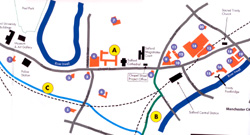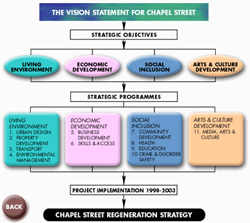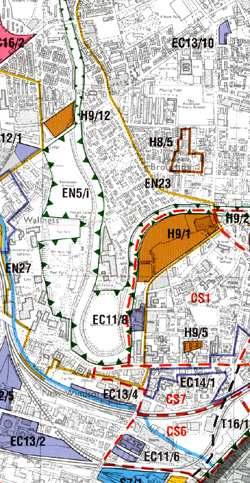
|
|
|
|
|
|
|||
|
|
|||
Chapel Street Regeneration Strategy
In December 1996 Salford City Council jointly with English Partnerships commissioned EDAW (an international planning and economic development consultancy) to prepare a Regeneration Strategy for the Chapel Street Corridor.
The final report was received from EDAW in July 1997 and approved by the City Council and English Partnerships in November 1997, with funding support confirmed over a five year period starting April 1998. It was to address the important physical, economic and social issues affecting the Chapel Street corridor. The loss of traditional industries and closure of facilities such as Salford Royal Hospital had reduced local employment opportunities, and left many surrounding sites vacant or underused. As a result, the appearance and image of the Corridor has suffered. Volume of traffic is a major concern, damaging the attractiveness of the area and adding to poor environmental quality.
The final report was received from EDAW in July 1997 and approved by the City Council and English Partnerships in November 1997, with funding support confirmed over a five year period starting April 1998.
The campus of Salford University forms the western most point of the strategy area and from the start the university has had close involvement with it's progress. Currently the Vice-Chancellor of the University, Michael Harloe, is the strategy chairman.
This is the vision statement:
"The Chapel Street Corridor will become a dynamic and competitive location close to the Regional Centre. The area will be a distinctive, attractive and a safe place to work, live and invest and will make a strategic contribution to the economic growth of the region. Its reputation for excellence will be focused on media, entrepreneurial activity and the arts and augmented by the profile and academic distinction of a leading edge University."
Over the past 4 years the Strategy seems to have had a large degree of success. There has been much redevelopment along the Chapel Street corridor, with several large housing schemes amongst the most notable achievements. However, this may in large part be attributable to the economic strength of neighboring Manchester City Centre and the consequent recent increases in land prices there, which have made Chapel Street an attractive alternative. The University is planning to captialise on it's involvement by rationalising and extending it's Adelphi Campus with a possible new bridge link across the loop in the Irwell to the Peel Park Campus. Any direct and positive affect on the surrounding badly deprived hosuing estates is year to be discerned.
Click Here to visit the website.
Salford Unitary Development Plan
The Salford Unitary Development Plan (UDP) is the sole statutory land-use plan for the whole City. When it was published in 1995 it superseded the Greater Manchester Structure Plan and the twelve Local Plans which previously covered different parts of the City. The Plan is currently under review, and a 2002 Plan is to be published imminently so consequently much of the data available is somewhat out of date.
Implementation of the plan depends on both public and private sector investment, and it primarily helps establish priorities for action and provides a framework for various local, national and European expenditure programmers.
The UDP features various issues for the study area. Most prominant is the Wildlife corridor indicated around the Irwell River and Peel Park. This highlights the importance that is now placed on this historic park and the adjacent river. The plan points out that the river has been significantly cleaned up over recent years and has seen a wide variety of wildlife returning. However, it is still not easy to walk along by the river and enjoy the wildlife.
A small industrial site directly adjacent to the river across from the main university campus is flagged up in the Plan under Policy EC8:
"The City Council will encourage the relocation of uses which do not conform with and which have a serious detrimental effect on the character, environment or amenity of their surrounding area."




